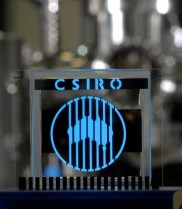By Merrin Fabre
Planes are like the whales of the sky. They’re big, they travel through a fluid, and they need a lot of fuel to get them moving. But while there is a lot of krill freely available for whales, the fuel needed to power planes is quite costly.
So what can be done save a little cash and hopefully reduce greenhouse gas emissions? Reducing the weight of an aircraft certainly reduces the amount of fuel needed for the thousands of take-offs during its service life – and therefore the cost to fly it.
Our researchers in the area of flexible electronics have been working with an airline company to look at ways of potentially reducing the weight and efficiency of planes.
Using OLEDs – or organic light-emitting diodes – on planes could be a potential solution. OLEDs emit light when an electric current is applied to them.
An organic light emitting diode showing the old-CSIRO logo.
The advantages of OLEDs are that they are lightweight, efficient and flexible. OLED panels can also emit light across a range of colours and, in contrast to normal light globes, they emit light in a very diffuse and even way – perfect for mood lighting in an aircraft cabin interior.
‘Every kilo of weight saved on a plane saves you money’, says Gerry Wilson the leader of the Flexible Electronics Theme.
‘Light weight flexible electronics could be one way of providing an environmentally friendly solution to reducing the cost of aviation.’
OLEDs are starting to appear in the latest television screens, computer monitors, and small, portable displays such as mobile phones and cameras.
‘One possible use of OLEDs on planes is in seat-mounted TV screens – not only would the screen be lighter (by replacing the glass) but the viewing experience would be better due to the wider viewing angle and better colour rendition’, says Gerry.
It all seems too good to be true. There is still more work to be done to apply these technologies to planes but with planes like the Boeing 747-400ER that carries more than 240 370L of fuel for one long-haul flight there is a definite need to lighten that load.


